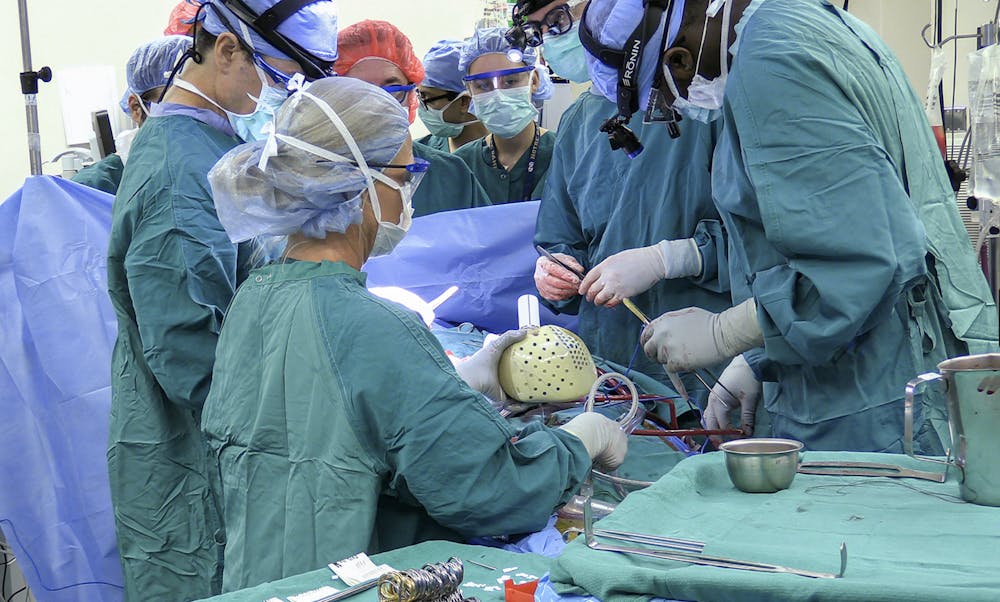A Duke medical team successfully performed the first new generation artificial heart transplant in history in July. Over a month later, recipient Matthew Moore is recovering as expected.
The recipient’s wife and a nurse by training, Rachel Moore, feels both thankful and optimistic about her husband’s recovery.
“We had no idea what to anticipate with this device, you know, with him being the first one here,” Rachel told The Chronicle. “I would say the entire postoperative course has been surprising, because he's done so well.”
Rachel mentioned that her husband has started walking with the help of physical therapy and that all of his organs are functioning well. She emphasized that the current focus is helping her husband rebuild his strength due to the significant loss of muscle mass during the transplant.
Currently, Matthew is unable to physically leave the hospital, so the couple has been spending most of their time together there. Once he is allowed to leave, Rachel anticipates that her husband will have monthly appointments with cardiologists.
“Once we get home, it will just be a different type of normalcy, but we just anticipate that this will just become part of our life and we'll just warm with that until he is called for an actual transplant,” Rachel said. “I just want to express our gratitude toward these physicians and their entire teams.”
Sharon McCartney, a cardiothoracic anesthesiologist and intensivist at Duke University Hospital, helped institute ventilation, maintain stable heart function and perform an ultrasound of the heart during Matthew’s procedure. She is hopeful that his success will open the door to future patients receiving a second chance at life.
“As an intensivist, I have had to be the person to tell a patient and their family members that they are not a transplant candidate and we do not have anything more to offer to them. I have had to watch the agony and the pain that causes,” McCartney wrote in an email. “Being involved in this device has given me hope for the patients that suffer from heart failure of both sides of the heart.”
Once the artificial heart—technically referred to as a CARMAT device—is implanted, the patient will then be able to live for months until a suitable organ is available. For heart transplant candidates that are too sick to wait for an eligible donor heart to become available, Matthew’s procedure provides an alternative option.
“The CARMAT device may provide an option for them in which they can live at home for many more years,” McCartney wrote. “We call this destination therapy, and while we aren’t trialing the CARMAT for this yet in the United States, it has been done in Europe with a patient having the device and living a normal life for two years so far.”
McCartney noted that Duke University Hospital performs a large amount of heart transplants and ventricular assist devices per year, as the medical staff cares for many patients that suffer from heart failure involving both sides of the heart.
“[This procedure] means a great deal to me as both an alum of [Duke’s School of Medicine] and being current Chief,” said Dr. Edward Chen, chief of the division of cardiovascular and thoracic surgery. “I am extremely proud of the entire transplant team for providing the highest level of quality care which exists for end-stage cardiac disease and continually looking for new and innovative ways to improve upon that care.”
Rachel emphasized that it was a very easy decision to go with the CARMAT; the couple was initially anxious when he went into cardiac arrest, but now that Matthew can hear the device in his chest, the couple is far less anxious about the chances of another heart attack. She also noted that while her husband remains on the transplant list for an actual heart, she anticipates that the CARMAT could potentially become an option that replaces the need for donor hearts.
“I will be happy to talk with anyone because this isn't just Matt's story,” Rachel said. “It's a story of his life, but it's also the story of this device, and the origination of this device, in this country. And from what we have seen, I certainly anticipate fully for this to be the start of this device being very helpful for patients in the years and years and years to come.”
Get The Chronicle straight to your inbox
Sign up for our weekly newsletter. Cancel at any time.

